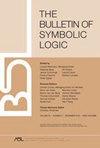Strong logics of first and second order
IF 1.1
3区 数学
Q1 LOGIC
引用次数: 27
Abstract
In this paper we investigate strong logics of first and second order that have certain absoluteness properties. We begin with an investigation of first order logic and the strong logics co-logic and /?-logic, isolating two facets of absoluteness, namely, generic invariance and faithfulness. It turns out that absoluteness is relative in the sense that stronger background assumptions secure greater degrees of absoluteness. Our aim is to investigate the hierarchies of strong logics of first and second order that are generically invariant and faithful against the backdrop of the strongest large cardinal hypotheses. We show that there is a close correspondence between the two hierarchies and we characterize the strongest logic in each hierarchy. On the first-order side, this leads to a new presentation of Woodin's Q-logic. On the second-order side, we compare the strongest logic with full second-order logic and argue that the comparison lends support to Quine's claim that second-order logic is really set theory in sheep's clothing. This paper is concerned with strong logics of first and second order. At the most abstract level, a strong logic of first-order has the following general form: Let L be a first-order language and let (x) be a formula that defines a class of L-structures. Then, for a recursively enumerable set T of sentences of L, and for a sentence ip of L set强大的一阶和二阶逻辑
本文研究了具有一定绝对性的一阶和二阶强逻辑。我们首先研究一阶逻辑和强逻辑,协逻辑和/?-逻辑,孤立绝对性的两个方面,即一般不变性和忠实性。事实证明,绝对性是相对的,因为更强的背景假设确保了更大程度的绝对性。我们的目的是研究一阶和二阶强逻辑的层次结构,这些逻辑是一般不变的,并且在最强的大基数假设的背景下是忠实的。我们证明了两个层次之间存在密切的对应关系,并描述了每个层次中最强的逻辑。在一阶方面,这导致了Woodin Q-logic的一种新的表示。在二阶方面,我们将最强逻辑与完整二阶逻辑进行比较,并认为这种比较支持了奎因的说法,即二阶逻辑实际上是披着羊皮的集合理论。本文研究一阶和二阶强逻辑。在最抽象的层面上,一阶强逻辑具有以下一般形式:设L为一阶语言,设(x)为定义一类L结构的公式。然后,对于L的句子的递归可枚举集合T,对于L的句子的ip集合
本文章由计算机程序翻译,如有差异,请以英文原文为准。
求助全文
约1分钟内获得全文
求助全文
来源期刊
CiteScore
0.60
自引率
0.00%
发文量
32
审稿时长
>12 weeks
期刊介绍:
The Bulletin of Symbolic Logic was established in 1995 by the Association for Symbolic Logic to provide a journal of high standards that would be both accessible and of interest to as wide an audience as possible. It is designed to cover all areas within the purview of the ASL: mathematical logic and its applications, philosophical and non-classical logic and its applications, history and philosophy of logic, and philosophy and methodology of mathematics.

 求助内容:
求助内容: 应助结果提醒方式:
应助结果提醒方式:


